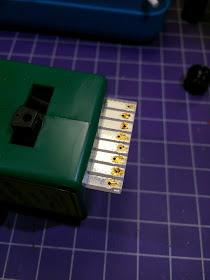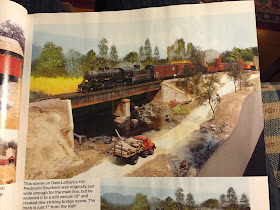But down on the Shore Line where the Valley connects in Old Saybrook, it's a different story. The switches are thrown remotely by the Saybrook tower operator. And on my layout, they're thrown by machines controlled by toggles on a control board. It's a pretty cool contrast to how things are done on the branch. But it's pretty annoying when you have to add additional turnouts. In addition to a new machine, every new turnout needs a new toggle (though crossovers can be controlled by 1 toggle), so the toggles need to be added to the board. And the diagram on the board itself needs to be changed eventually too.
The prototype had to do this from time to time as well, so that's some consolation.
 |
| Buzzards Bay, MA control board, posted by John S Greene on the New York New Haven & Hartford Railroad group on Facebook |
 |
| Click to enlarge and see the new markings showing the new track arrangement. The post-it shows where the new toggles will go. |
So, opening up the panel, here's what we see (click here for how I built the panel):
I've already drilled a new hole for the additional wires and the new wires are poking through.
Next, I needed to drill new holes for toggles, including routing out recesses (as described here).
 |
| I already had one extra hole from before - I wish I'd thought ahead more. Oh well. I extended the center line and marked 1" centers. |
 |
| Then it was a matter of drilling a small pilot hole (1/8"), then the toggle hole (1/4"), then the recess (5/8" spade bit, then - when that was insufficient a 3/4" spade bit). |
Having previously wired up the additional toggles conveniently at my workbench (as I describe here), it was just a matter of putting them in - the most complicated task was soldering the toggle wires to the power bus (I ended up unsoldering a couple of the other connections in the process, but that was easily corrected - once I discovered the problem).
By contrast, one of the least-stressful (and almost relaxing) steps in the process, was cutting the remaining wires to length and connecting them to the terminal strips.
 |
| You can see the additional terminals I've added, as well as the additional wires - all nicely labeled. |
The pic above show everything all connected. Well, almost everything. As you can see (or maybe not, considering the bundle of wires) there are some loops of disconnected wire. Those are the wires from the new toggles that will go to the LED indicators. I haven't done those yet because 1) I need to find 3 more 5mm green 3v LED bulbs, and b) I need to redo the track diagram (and by "I" I mean Bill, hopefully) and won't know where the bulbs (and their associated mounting holes) will go until that's (re)done and (re)mounted.
We'll make it look all nicey nice when I/Bill have the extra time. That'll be "Control Board, Part 2." But for now, everything is functioning so it's ready to go for my next shake-down session.
 |
| Control Board in its current state - 17 toggles, all marked up, and temporarily relabeled. |













































